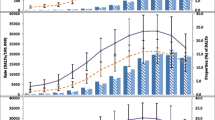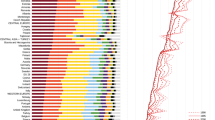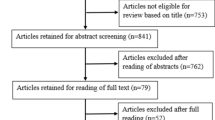Abstract
Background
Diet is a major determining factor for many non-communicable chronic diseases (NCDs). However, evidence on diet-related NCD burden remains limited. We assessed the trends in diet-related NCDs in Australia from 1990 to 2015 and compared the results with other countries of the Organization for Economic Co-operation and Development (OECD).
Methods
We used data and methods from the Global Burden of Disease (GBD) 2015 study to estimate the NCD mortality and disability-adjusted life years (DALYs) attributable to 14 dietary risk factors in Australia and 34 OECD nations. Countries were further ranked from the lowest (first) to highest (35th) burden using an age-standardized population attributable fraction (PAF).
Results
In 2015, the estimated number of deaths attributable to dietary risks was 29,414 deaths [95% uncertainty interval (UI) 24,697 − 34,058 or 19.7% of NCD deaths] and 443,385 DALYs (95% UI 377,680–511,388 or 9.5% of NCD DALYs) in Australia. Young (25–49 years) and middle-age (50–69 years) male adults had a higher PAF of diet-related NCD deaths and DALYs than their female counterparts. Diets low in fruits, vegetables, nuts and seeds and whole grains, but high in sodium, were the major contributors to both NCD deaths and DALYs. Overall, 42.3% of cardiovascular deaths were attributable to dietary risk factors. The age-standardized PAF of diet-related NCD mortality and DALYs decreased over the study period by 28.2% (from 27.0% in 1990 to 19.4% in 2015) and 41.0% (from 14.3% in 1990 to 8.4% in 2015), respectively. In 2015, Australia ranked 12th of 35 examined countries in diet-related mortality. A small improvement of rank was recorded compared to the previous 25 years.
Conclusions
Despite a reduction in diet-related NCD burden over 25 years, dietary risks are still the major contributors to a high burden of NCDs in Australia. Interventions targeting NCDs should focus on dietary behaviours of individuals and population groups.

[adapted from the Global Burden of Disease (GBD) 2015 Risk Factors Study. This figure depicts a summary which the process of dietary risk methods were conducted. Methods that are more detailed can be accessed from the GBD 2015 Risk Factors Study]

Similar content being viewed by others
References
Leenders M, Sluijs I, Ros MM, Boshuizen HC, Siersema PD et al (2013) Fruit and vegetable consumption and mortality European prospective investigation into cancer and nutrition. Am J Epidemiol 178(4):590–602. https://doi.org/10.1093/aje/kwt006
Rohrmann S, Overvad K, Bueno-de-Mesquita HB, Jakobsen MU, Egeberg R et al (2013) Meat consumption and mortality-results from the European Prospective Investigation into Cancer and Nutrition. BMC Med 11:63. https://doi.org/10.1186/1741-7015-11-63
Kurotani K, Akter S, Kashino I, Goto A, Mizoue T et al (2016) Quality of diet and mortality among Japanese men and women: Japan Public Health Center based prospective study. Br Med J. https://doi.org/10.1136/bmj.i1209
Imamura F, Micha R, Khatibzadeh S, Fahimi S, Shi P et al (2015) Dietary quality among men and women in 187 countries in 1990 and 2010: a systematic assessment. Lancet Glob Health 3:e132–e142
World Health Organization (2016) United Nations decades of action on nutrition. World Health Organization. http://www.who.int/nutrition/decade-of-action/en/. Accessed 4 Jan 2017
Han E, Powell LM (2013) Consumption patterns of sugar-sweetened beverages in the United States. J Acad Nutr Diet 113:43–53
Australian Institute of Health and Welfare (2016) Australian Burden of Disease Study: impact and causes of illness and death in Australia 2011. Australian Burden of Disease Study series no. 3. BOD 4. AIHW, Canberra
Forouzanfar MH, Afshin A, Alexander LT, Anderson HR, Bhutta ZA et al (2016) Global, regional, and national comparative risk assessment of 79 behavioural, environmental and occupational, and metabolic risks or clusters of risks, 1990–2015: a systematic analysis for the Global Burden of Disease Study 2015. Lancet 388:1659–1724. https://doi.org/10.1016/S0140-6736(16)31679-8
Melaku YA, Temesgen AM, Deribew A, Tessema GA, Deribe K et al (2016) The impact of dietary risk factors on the burden of non-communicable diseases in Ethiopia: findings from the Global Burden of Disease study 2013. Int J Behav Nutr Phys Act 13:122. https://doi.org/10.1186/s12966-016-0447-x
World Cancer Research Fund / American Institute for Cancer Research (2011) Continuous update project report. Food, nutrition, physical activity, and the prevention of colorectal cancer. WCRF International, London
Mozaffarian D, Hao T, Rimm EB, Willett WC, Hu FB (2011) Changes in diet and lifestyle and long-term weight gain in women and men. N Engl J Med 364:2392–2404. https://doi.org/10.1056/NEJMoa1014296
Powles J, Fahimi S, Micha R, Khatibzadeh S, Shi P et al (2013) Global, regional and national sodium intakes in 1990 and 2010: a systematic analysis of 24 h urinary sodium excretion and dietary surveys worldwide. BMJ Open. https://doi.org/10.1136/bmjopen-2013-003733
Wang H, Naghavi M, Allen C, Barber RM, Bhutta ZA et al (2016) Global, regional, and national life expectancy, all-cause mortality, and cause-specific mortality for 249 causes of death, 1980–2015: a systematic analysis for the Global Burden of Disease Study 2015. Lancet 388:1459–1544. https://doi.org/10.1016/S0140-6736(16)31012-1
Vos T, Allen C, Arora M, Barber RM, Bhutta ZA et al (2016) Global, regional, and national incidence, prevalence, and years lived with disability for 310 diseases and injuries, 1990–2015: a systematic analysis for the Global Burden of Disease Study 2015. Lancet 388:1545–1602. https://doi.org/10.1016/S0140-6736(16)31678-6
Kassebaum NJ, Arora M, Barber RM, Bhutta ZA, Brown J et al (2016) Global, regional, and national disability-adjusted life-years (DALYs) for 315 diseases and injuries and healthy life expectancy (HALE), 1990–2015: a systematic analysis for the Global Burden of Disease Study 2015. Lancet 388:1603–1658. https://doi.org/10.1016/S0140-6736(16)31460-X
Naghavi M, Wang H, Lozano R, Davis A, Liang X et al (2015) Global, regional, and national age–sex specific all-cause and cause-specific mortality for 240 causes of death, 1990–2013: a systematic analysis for the Global Burden of Disease Study 2013. Lancet 385:117–171. https://doi.org/10.1016/S0140-6736(14)61682-2
[Institute for Health Metrics and Evaluation (IHME) (2016) GBD Compare. Seattle, WA: IHME, University of Washington, 2016. http://vizhub.healthdata.org/gbd-compare. Accessed 1 Mar 2016
World Health Organization (2009) Global health risk: mortality and burden of disease attributable to selected major risks. World Health Organization, Geneva
Cullen KW, Thompson D, Boushey C, Konzelmann K, Chen TA (2013) Evaluation of a web-based program promoting healthy eating and physical activity for adolescents: teen choice: food and fitness. Health Educ Res 28:704–714
Smith-Spangler CM, Juusola JL, Enns EA, Owens DK, Garber AM (2010) Population strategies to decrease sodium intake and the burden of cardiovascular disease—a cost-effectiveness analysis. Ann Intern Med 152:481–487. https://doi.org/10.7326/0003-4819-152-8-201004200-00212
Scarborough P, Bhatnagar P, Wickramasinghe KK, Allender S et al (2011) The economic burden of ill health due to diet, physical inactivity, smoking, alcohol and obesity in the UK: an update to 2006–07 NHS costs. J Public Health 33:527–535. https://doi.org/10.1093/pubmed/fdr033
Forouzanfar MH, Alexander L, Anderson HR, Bachman VF, Biryukov S et al (2015) Global, regional, and national comparative risk assessment of 79 behavioural, environmental and occupational, and metabolic risks or clusters of risks in 188 countries, 1990–2013: a systematic analysis for the Global Burden of Disease Study 2013. Lancet 386:2287–2323. https://doi.org/10.1016/S0140-6736(15)00128-2
Zheng M, Wu JHY, Louie JCY, Flood VM, Gill T et al (2016) Typical food portion sizes consumed by Australian adults: results from the 2011–12 Australian National Nutrition and Physical Activity Survey. Sci Rep 6:19596. https://doi.org/10.1038/srep19596
Land M-A, Webster J, Christoforou A, Praveen D, Jeffery P et al (2014) Salt intake assessed by 24 h urinary sodium excretion in a random and opportunistic sample in Australia. BMJ Open 4:e003720
Sui Z, Raubenheimer D, Cunningham J, Rangan A (2016) Changes in meat/poultry/fish consumption in Australia: From 1995 to 2011–2012. Nutrients 8:753
Mozaffarian D, Fahimi S, Singh GM, Micha R, Khatibzadeh S et al (2014) Global sodium consumption and death from cardiovascular causes. N Engl J Med 371:624–634
Micha R, Wallace SK, Mozaffarian D (2010) Red and processed meat consumption and risk of incident coronary heart disease, stroke, and diabetes mellitus a systematic review and meta-analysis. Circulation 121:2271–2283
Bouvard V, Loomis D, Guyton KZ, Grosse Y, Ghissassi FE et al (2015) Carcinogenicity of consumption of red and processed meat. Lancet Oncol 16:1599–1600. https://doi.org/10.1016/S1470-2045(15)00444-1
Mhurchu CN, Capelin C, Dunford EK, Webster JL, Neal BC, Jebb SA (2011) Sodium content of processed foods in the United Kingdom: analysis of 44,000 foods purchased by 21,000 households. Am J Clin Nutr 93:594–600
Ruel G, Shi Z, Zhen S, Zuo H, Kröger E et al (2014) Association between nutrition and the evolution of multimorbidity: the importance of fruits and vegetables and whole grain products. Clin Nutr 33:513–520. https://doi.org/10.1016/j.clnu.2013.07.009
Australian Dietary Guidelines (2013) Canberra: National Health and Medical Research Council. http://www.eatforhealth.gov.au. Accessed 23 Oct 2016
World Health Organization (WHO) (2003) Diet, nutrition, and the prevention of chronic diseases. WHO technical report series no. 916. WHO, Geneva
Taylor AW, Dal Grande E, Wu J, Shi Z, Campostrini S (2014) Ten-year trends in major lifestyle risk factors using an ongoing population surveillance system in Australia. Popul Health Metr 12:1–13. https://doi.org/10.1186/s12963-014-0031-z
Pollard CM, Miller MR, Daly AM, Crouchley KE, O’Donoghue KJ et al (2008) Increasing fruit and vegetable consumption: success of the Western Australian Go for 2&5® campaign. Public Health Nutr 11:314
Australian Bureau of Statistics (2012) Australian Health Survey: Updated Results, 2011–12. Daily intake of fruit and vegetables. http://www.abs.gov.au/ausstats/abs@.nsf/Lookup/C549D4433F6B74D7CA257B8200179569?opendocument. Accessed 13 May 2016
Tobias M, Turley M, Stefanogiannis N, Hoorn SV, Lawes C et al (2006) Vegetable and fruit intake and mortality from chronic disease in New Zealand. Aust N Z J Public Health 30:26–31
Pomerleau J, Lock K, Knai C, McKee M (2005) Interventions designed to increase adult fruit and vegetable intake can be effective: a systematic review of the literature. J Nutr 135:2486–2495
Lee AJ, Kane S, Ramsey R, Good E, Dick M (2016) Testing the price and affordability of healthy and current (unhealthy) diets and the potential impacts of policy change in Australia. BMC Public Health 16:1–22. https://doi.org/10.1186/s12889-016-2996-y
Afshin A, Penalvo J, Del Gobbo L, Kashaf M, Micha R et al (2015) CVD prevention through policy: a review of mass media, food/menu labeling, taxation/subsidies, built environment, school procurement, worksite wellness, and marketing standards to improve diet. Curr Cardiol Rep 17:98. https://doi.org/10.1007/s11886-015-0658-9
Murray CJL, Richards MA, Newton JN, Fenton KA, Anderson HR et al (2013) UK health performance: findings of the Global Burden of Disease Study 2010. Lancet 381:997–1020. https://doi.org/10.1016/S0140-6736(13)60355-4
Australian Bureau of Statistics (2012): The role of beverages in the Australian diet: a secondary analysis of the Australian Health Survey. National Nutrition and Physical Activity Survey, 2011–12. ABS, Australia
Shi Z, Ruel G, Grande ED, Pilkington R, Taylor AW (2015) Soft drink consumption and multimorbidity among adults. Clin Nutr ESPEN 10:e71–e76. https://doi.org/10.1016/j.clnesp.2015.01.001
Greenwood D, Threapleton D, Evans C, Cleghorn C, Nykjaer C et al (2014) Association between sugar-sweetened and artificially sweetened soft drinks and type 2 diabetes: systematic review and dose–response meta-analysis of prospective studies. Br J Nutr 112:725–734
Anand SS, Hawkes C, de Souza RJ, Mente A, Dehghan M et al (2015) Food consumption and its impact on cardiovascular disease: importance of solutions focused on the globalized food system—a report from the workshop convened by the world heart federation. J Am Coll Cardiol 66:1590–1614. https://doi.org/10.1016/j.jacc.2015.07.050
Moshtaghian H, Louie JCY, Charlton KE, Probst YC, Gopinath B et al (2016) Added sugar intake that exceeds current recommendations is associated with nutrient dilution in older Australians. Nutrition 32:937–942. https://doi.org/10.1016/j.nut.2016.02.004
Grimes CA, Wright JD, Liu K, Nowson CA, Loria CM (2013) Dietary sodium intake is associated with total fluid and sugar-sweetened beverage consumption in US children and adolescents aged 2–18 years: NHANES 2005–2008. Am J Clin Nutr 98:189–196
Imamura F, O’Connor L, Ye Z, Mursu J, Hayashino Y et al (2016) Consumption of sugar sweetened beverages, artificially sweetened beverages, and fruit juice and incidence of type 2 diabetes: systematic review, meta-analysis, and estimation of population attributable fraction. Br J Sports Med 50:496–504
Colchero MA, Popkin BM, Rivera JA, Ng SW (2016) Beverage purchases from stores in Mexico under the excise tax on sugar sweetened beverages: observational study. Br Med J 352
Veerman JL, Sacks G, Antonopoulos N, Martin J (2016) The impact of a tax on sugar-sweetened beverages on health and health care costs: a modelling study. PLoS One 11:e0151460. https://doi.org/10.1371/journal.pone.0151460
Fletcher JM, Frisvold D, Tefft N (2010) Can soft drink taxes reduce population weight? Contemp Econ Policy 28:23–35. https://doi.org/10.1111/j.1465-7287.2009.00182.x
Afshin A, Micha R, Khatibzadeh S, Mozaffarian D (2014) Consumption of nuts and legumes and risk of incident ischemic heart disease, stroke, and diabetes: a systematic review and meta-analysis. Am J Clin Nutr 100:278–288. https://doi.org/10.3945/ajcn.113.076901
Wyness LA, Butriss JL, Stanner SA (2012) Reducing the population’s sodium intake: the UK Food Standards Agency’s salt reduction programme. Public Health Nutr 15:254–261. https://doi.org/10.1017/s1368980011000966
Sonnenberg L, Gelsomin E, Levy DE, Riis J, Barraclough S, Thorndike AN (2013) A traffic light food labeling intervention increases consumer awareness of health and healthy choices at the point-of-purchase. Prev Med 57:253–257. https://doi.org/10.1016/j.ypmed.2013.07.001
Bollard T, Maubach N, Walker N, Ni Mhurchu C (2016) Effects of plain packaging, warning labels, and taxes on young people’s predicted sugar-sweetened beverage preferences: an experimental study. Int J Behav Nutr Phys Act 13:95. https://doi.org/10.1186/s12966-016-0421-7
Cobiac LJ, Tam K, Veerman L, Blakely T (2017) Taxes and subsidies for improving diet and population health in australia: a cost-effectiveness modelling study. PLoS Med 14:e1002232. https://doi.org/10.1371/journal.pmed.1002232
Livingstone KM, Celis-Morales C, Navas-Carretero S, San-Cristobal R et al (2016) Profile of European adults interested in internet-based personalised nutrition: the Food4Me study. Eur J Nutr 55:759–769
Wakefield MA, Coomber K, Durkin SJ, Scollo M, Bayly M et al (2014) Time series analysis of the impact of tobacco control policies on smoking prevalence among Australian adults, 2001–2011. Bull World Health Org 92:413–422
Afshin A, Babalola D, McLean M, Yu Z, Ma W et al (2016) Information technology and lifestyle: a systematic evaluation of internet and mobile interventions for improving diet, physical activity, obesity, tobacco, and alcohol use. J Am Heart Assoc. https://doi.org/10.1161/jaha.115.003058
Kerr DA, Harray AJ, Pollard CM, Dhaliwal SS, Delp EJ et al (2016) The connecting health and technology study: a 6-month randomized controlled trial to improve nutrition behaviours using a mobile food record and text messaging support in young adults. Int J Behav Nutr Phys Act 13:52. https://doi.org/10.1186/s12966-016-0376-8
Acknowledgements
We are grateful to The Institute of Health Metrics and Evaluation for availing the data. We appreciate Assistant Professor Ashkan Afshin for his guidance in the early stage of manuscript preparation. YAM is thankful for the support provided by the Australian Government Research Training Program Scholarship. AR is supported by an Australian Research Council Future Fellowship (FT110100345). BdC is supported by National Heart Foundation Future Leader Fellowship (100864). EB is a recipient of the Monash Graduate and Monash International Postgraduate Scholarships.
Funding
No funding was received for this specific study. GBD 2015 was funded by Bill & Melinda Gates Foundation.
Author information
Authors and Affiliations
Corresponding author
Ethics declarations
Conflict of interest
All authors declare they have no competing interests. The authors are solely responsible for the views expressed in this article, and they do not necessarily represent the views, decisions, or policies of their institutions.
Informed consent
Not applicable because the manuscript does not include details, images, or videos relating to individual participants.
Ethics and consent
Not applicable.
Electronic supplementary material
Below is the link to the electronic supplementary material.
Rights and permissions
About this article
Cite this article
Melaku, Y.A., Renzaho, A., Gill, T.K. et al. Burden and trend of diet-related non-communicable diseases in Australia and comparison with 34 OECD countries, 1990–2015: findings from the Global Burden of Disease Study 2015. Eur J Nutr 58, 1299–1313 (2019). https://doi.org/10.1007/s00394-018-1656-7
Received:
Accepted:
Published:
Issue Date:
DOI: https://doi.org/10.1007/s00394-018-1656-7




